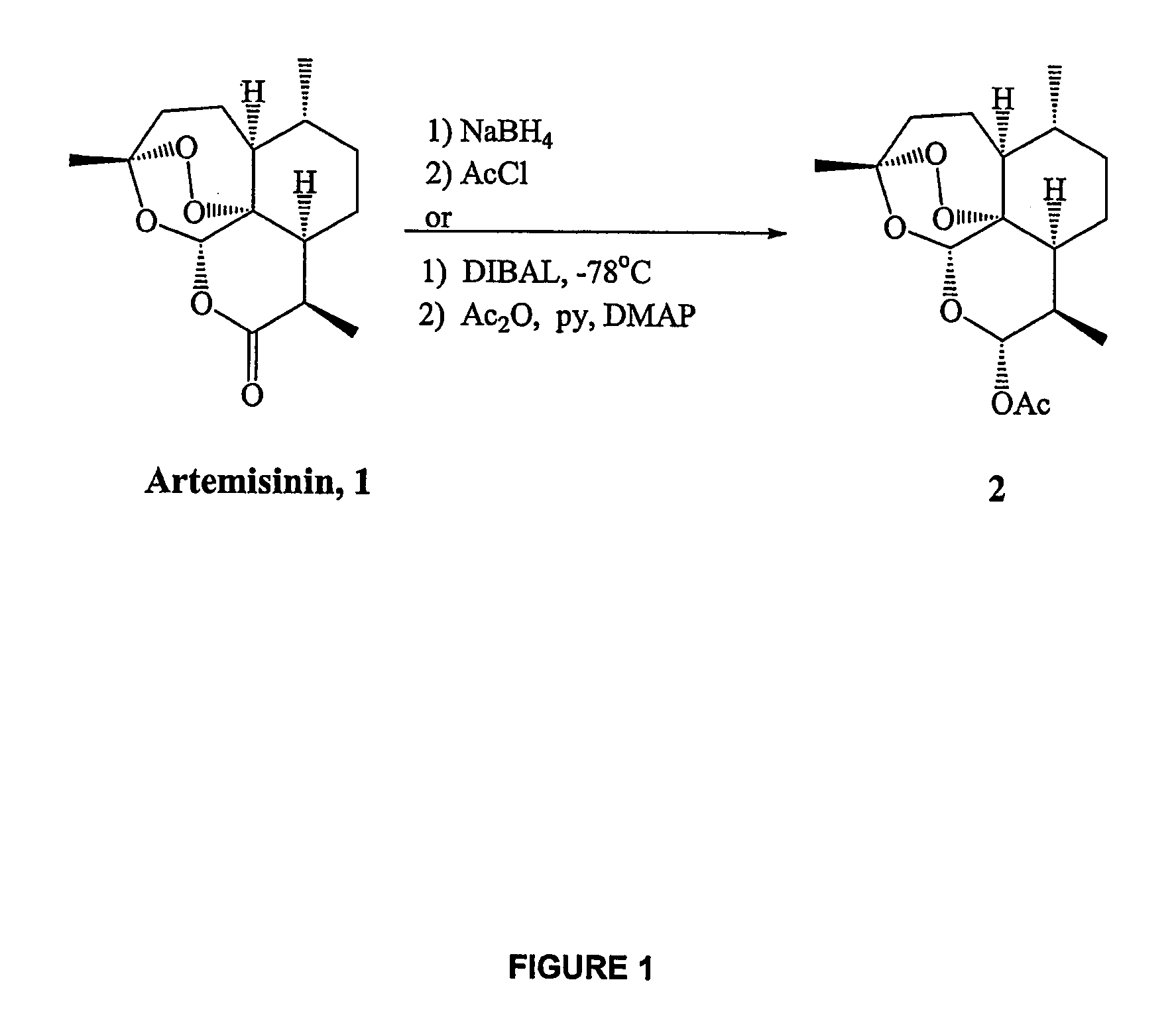Orally active, antimalarial, anticancer, artemisinin-derived trioxane dimers
a trioxane dimer, anticancer technology, applied in the direction of heterocyclic compound active ingredients, biocide, group 5/15 element organic compounds, etc., can solve the problems of difficult chemical modification of artemisinin, unsatisfactory control slow formation of (ii-1), and difficult task of scientists to modify artemisinin, etc., to achieve more orally effective anticancer, potent and selective anticancer activity, and improved anticancer
- Summary
- Abstract
- Description
- Claims
- Application Information
AI Technical Summary
Benefits of technology
Problems solved by technology
Method used
Image
Examples
example 1
Synthesis of bis-trioxane O-allyl ether 12a and bis-trioxane O-acetic acid 12b
Synthesis of bis-trioxane O-allyl ether 12a.
[0230]To a solution of bis-trioxane primary alcohol 4 (200 mg, 0.33 mmol) in anhydrous tetrahydrofuran (20 mL) at −78° C. was added KHMDS (0.5 M sol. in toluene, 2 mL, 1 mmol) in a dropwise manner. The reaction was stirred at −78° C. for 30 mins, at which time allyl bromide (0.4 mL, I mmol) and 18-crown-6 (catalytic) were added. The reaction was then stirred at −78° C. for a further 1 hour, at which time TLC analysis showed complete consumption of starting material. The reaction was quenched with water (5 mL) and organics were extracted with methylene chloride (3×20 mL), dried (MgSO4) and concentrated in vacuo. Column chromatography on silica eluting with 10-12% ethyl acetate / hexanes isolated bis-trioxane O-allyl ether 12a as a viscous oil (204 mg, 96%). 1H NMR (400 MHz, CDCl3) δ 5.98-5.88 (m, 1H), 5.32 (s, 2H), 5.28-5.23 (m, 1H), 5.14-5.10 (m, 1H), 4.34-4.28 (m,...
example 2
Synthesis of α-dihydroartemisinin acetate 2
[0232]To a solution of artemisinin 1 (565 mg, 2.00 mmol) in anhydrous methylene chloride (15.0 mL) at −78° C. was added DIBAL (1.0 M in toluene, 2.4 mL, 2.4 mmol) in a dropwise manner. The reaction was stirred at −78° C. for one hour, at which time TLC analysis confirmed complete consumption of starting material. Pyridine (0.50 mL, 6.18 mmol), 4-(dimethylamino)-pyridine (292 mg, 2.4 mmol) and finally acetic anhydride (0.760 mL, 8.05 mmol) were addded and the reaction was stirred vigorously at −78° C. for 3 hours before being allowed to warm to room temperature and stir overnight. The reaction was then quenched with saturated NH4Cl solution (20 mL) and organics were extracted with methylene chloride (3×20 mL), washed with brine, dried (MgSO4) and concentrated in vacuo. Flash column chromatography on silica eluting with 14% ethyl acetate / hexanes isolated α-dihydroartemisinin acetate 2 as a white solid (600 mg, 1.84 mmol, 92%) with the followi...
example 3
Synthesis of trioxane isobutene dimer 3
[0233]A solution of dihydroartemisinin acetate 2 (DHA acetate) (872 mg, 2.67 mmol) and the allylic bis-silane linker (267 mg, 1.34 mmol) in methylene chloride (50 mL) was cooled to −78° C. Tin tetrachloride (1M solution in CH2Cl2, 2.67 ml, 2.67 mmol) was further diluted with CH2Cl2 (3 mL) and was added to the reaction mixture dropwise using a syringe pump at the rate of 6 ml / hour. The reaction was stirred at −78° C. for a further 45 minutes at which time TLC analysis confirmed complete consumption of starting material. Saturated ammonium chloride solution (10 mL) was then added and the reaction was allowed to warm to room temperature naturally. Organics were extracted with methylene chloride (3×20 mL), dried (Na2SO4) and concentrated in vacuo. Gradient column chromatography on silica eluting with 5%, 7%, 8% and finally 10% ethyl acetate / hexanes isolated trioxane isobutene dimer 3 as a white solid (564 mg, 0.96 mmol, 71%). Mp=132-133° C.; 1H NMR...
PUM
| Property | Measurement | Unit |
|---|---|---|
| pH | aaaaa | aaaaa |
| doubling time | aaaaa | aaaaa |
| concentrations | aaaaa | aaaaa |
Abstract
Description
Claims
Application Information
 Login to View More
Login to View More - R&D
- Intellectual Property
- Life Sciences
- Materials
- Tech Scout
- Unparalleled Data Quality
- Higher Quality Content
- 60% Fewer Hallucinations
Browse by: Latest US Patents, China's latest patents, Technical Efficacy Thesaurus, Application Domain, Technology Topic, Popular Technical Reports.
© 2025 PatSnap. All rights reserved.Legal|Privacy policy|Modern Slavery Act Transparency Statement|Sitemap|About US| Contact US: help@patsnap.com



